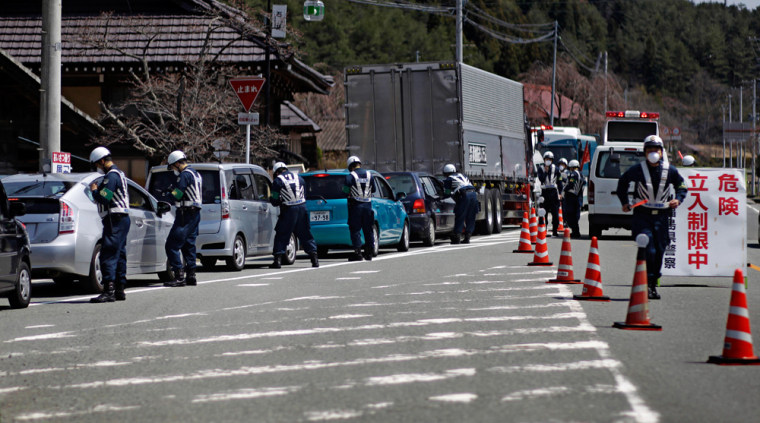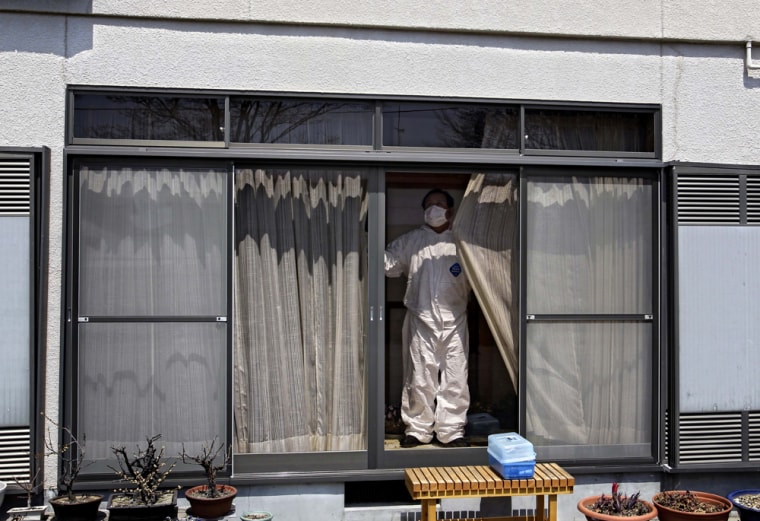Residents rushed back into the 12-mile evacuation zone around Japan's radiation-spewing nuclear power plant Thursday, grabbing whatever belongings they could before an order went into effect legally banning entry to the area.
Chief Cabinet Secretary Yukio Edano told a news conference that the ban would be introduced from midnight Thursday. Under the restriction, people can only go into the zone under government supervision.
"The setting of the no-entry zone and (last month's) evacuation instruction are aimed at securing the safety of the people," Edano said.
"We will take strict legal measures against those trying to enter the area," he said, without providing details. "For residents, all I can say is I ask for their understanding so that no legal action will be taken against them."
An earthquake with a magnitude of 6.3 hit the eastern portion of the country on Thursday evening, the U.S. Geological Survey said, but no tsunami warning was issued and there were no immediate reports of any casualties or damage.
'Our last chance'
A stream of evacuees ventured into deserted towns near the plant, some in white protective suits and others in face masks and rain gear they hoped would protect against radiation. Most raced through the zone with car windows closed, their vehicles crammed with clothing and valuables.
"This is our last chance, but we aren't going to stay long. We are just getting what we need and getting out," said Kiyoshi Kitajima, an X-ray technician, who dashed to his hospital in Futaba, a town next-door to the plant, to collect equipment before the order went into effect at midnight.
Officials said the order announced Thursday was meant to limit exposure to radiation leaking from the plant and to prevent thefts. Almost all the zone's nearly 80,000 residents left when the area was evacuated on March 12, but police had not been able to legally block them from going back.
Police had no estimate Thursday of the exact number of people who have returned to the zone or who still might be living there.
Under a special nuclear emergency law, people who enter the zone will now be subject to fines of up to 100,000 yen ($1,200) or possible detention of up to 30 days. Up to now, defiance of the evacuation order was not punishable by law.
The order angered some residents who fled their homes nearly empty-handed when they were told to evacuate after last month's tsunami and earthquake wrecked the Fukushima Dai-ichi plant's power and cooling systems.
"I initially thought we would be able to return within a few days. So I brought nothing except a bank card," said Kazuko Suzuki, 49, also from Futaba.
"I really want to go back. I want to check if our house is still there," said Suzuki, who fled with her teenage son and daughter. "My patience has run out. I just want to go home."
The no-go order was not due to any particular change in conditions inside the plant, which appear to have somewhat stabilized. Even under the best-case scenario, however, the plant's operator says it will take at least six months to bring its reactors safely into a cold shutdown.
Chief Cabinet Secretary Yukio Edano said authorities would arrange brief visits, allowing one person per household to return by bus for a maximum of two hours to collect necessary belongings. Participants would have to go through radiation screening, he said.
"We beg the understanding of residents. We really want residents not to enter the areas," Edano told reporters. "Unfortunately, there are still some people in the areas."
Residents chafed at the limit to just one person per household.
One zone will be off-limits
No visits will be allowed in a two-mile area closest to the plant, said Hidehiko Nishiyama of Japan's Nuclear and Industrial Safety Agency, confirming reports that zone would be completely off-limits.
Details were still being worked out.
Katsunobu Sakurai, mayor of Minami Soma, where about half the 71,000 residents lived in areas that will now be off-limits, questioned the rationale for the way the evacuation zone was decided.
"It feels like some outsider who doesn't know anything about our geography sat at a desk and drew these circles," Sakurai said. "The zones have zero scientific basis. Radiation doesn't travel in neat circles. Just putting up circles around the plant is unreasonable."

Prime Minister Naoto Kan, who has been under fire from the opposition over the government's handling of the crisis, visited the region Thursday, giving a giving a pep talk to workers at a nuclear crisis management center in Fukushima.
Fukushima's governor, who has also been critical of the government's performance, said he urged Kan to ensure the government properly handles the disaster and related compensation issues.
"I told the prime minister that I strongly hope that evacuees can return home as early as possible," said the governor, Yuhei Sato.
"Are you leaving?" one man shouted as Kan and his entourage headed for the door at a Fukushima evacuation center. "We are evacuees. Are you just going to ignore us?"
Kan turned back and apologized, only to be berated again.
"You should bring cabinet ministers here and let them try living here themselves. How do you think we feel? We want you to somehow get the nuclear plant under control," one woman said.
Later, Kan told reporters he had been out of touch with the needs of those who had lost their homes.
"I thought I knew how the people here felt but by coming here and actually talking to them, I got the renewed sense that I need to stand in their shoes more and think about their needs," he said.
Meanwhile, new data from Japan's National Police Agency showed that two-thirds of the victims identified in last month's earthquake and tsunami were elderly — and almost all of them drowned.
The agency said 65 percent of the 11,108 confirmed fatalities of known age were 60 or older. Another 1,899 victims were of unknown age.
Adding those who are still missing, the earthquake and resulting tsunami killed an estimated 27,500 people. The police agency said nearly 93 percent of the victims had drowned. Others perished in fires, were crushed to death or died from other causes.
The northeastern coast hardest hit by the disasters had a high concentration of elderly residents.
